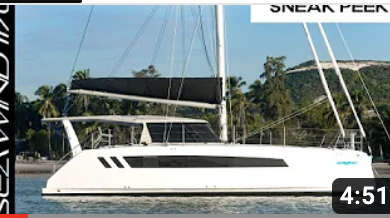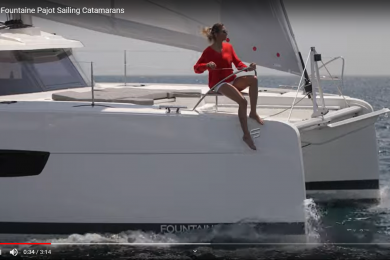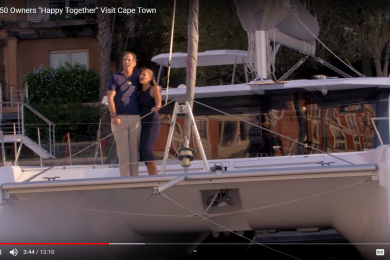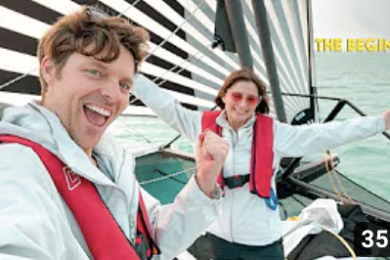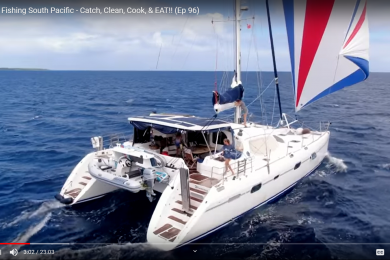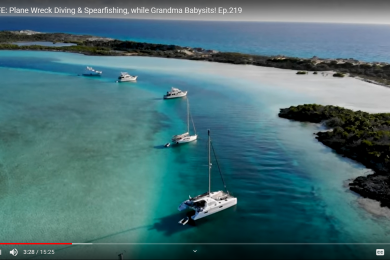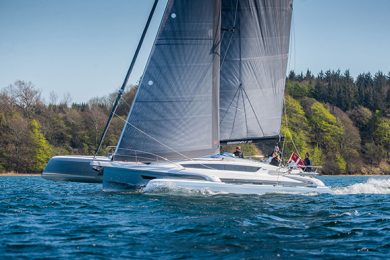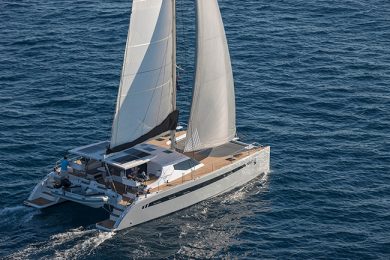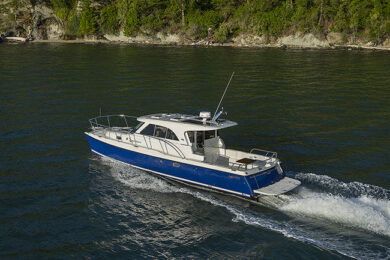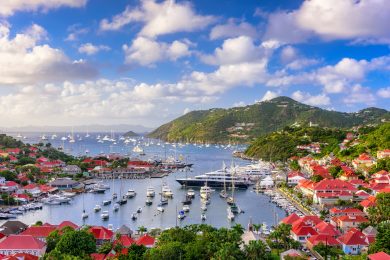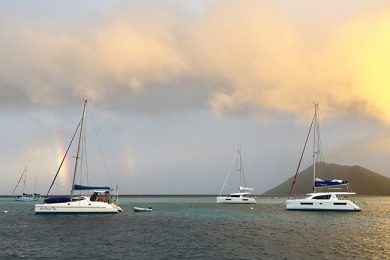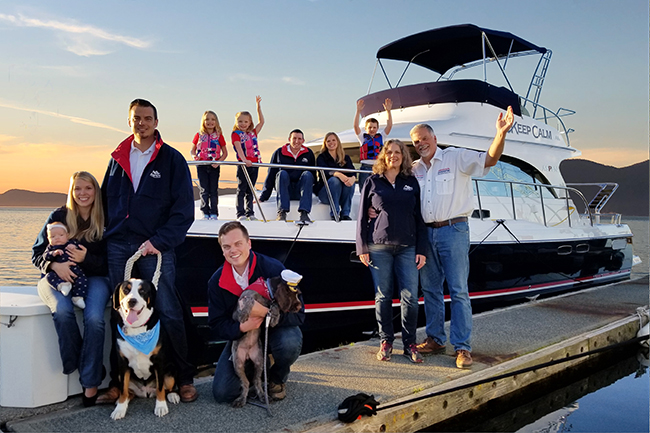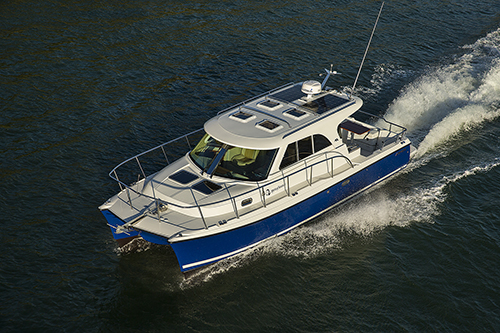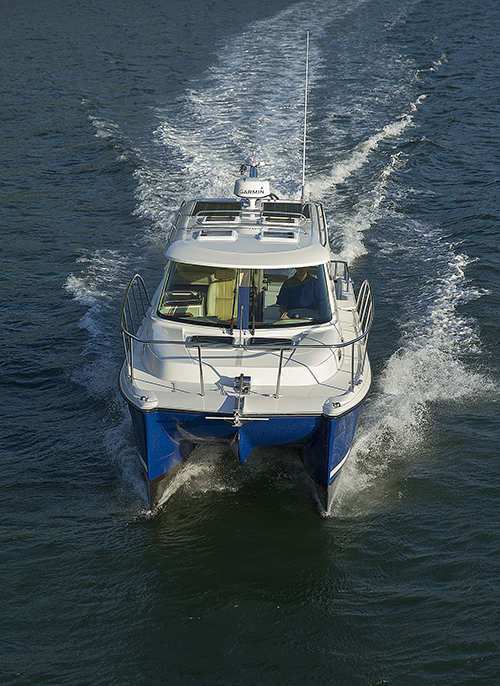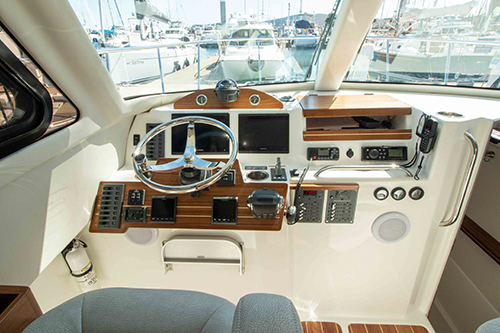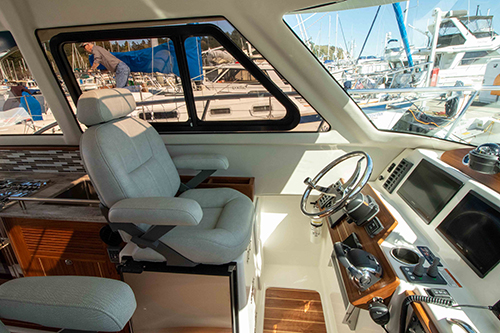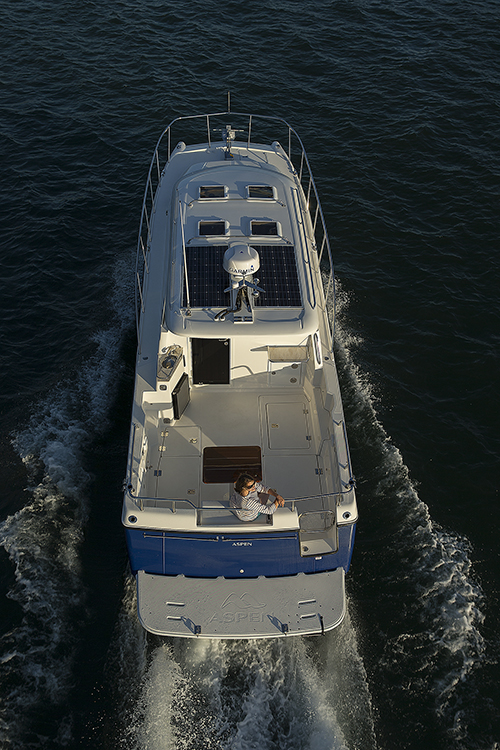Technology and innovation drive performance and efficiency in Aspen’s patented power proa cat design
When Larry Graf, the founder of Aspen Power Catamarans, invited me aboard a prototype of his new proa cat design in 2008 I was intrigued. He had created an innovative new hull design that would be the foundation for a series of efficient and easy-running power cats.
We ran the boat in Possession Sound near Everett, WA and from the beginning it was obvious that he was onto something. The boat ran smoothly and evenly and was remarkably efficient powered by a single inboard diesel.
The conditions were relatively calm, so we were forced to take sharp turns to try to run over our own wake in an attempt to gauge seakeeping. The problem was that the boat barely made a wake, so we just made tight donuts and figure eights on the water without much result. When another boat passed by, we raced toward it to cross its wake, which was equally undramatic. The Aspen’s hulls simply sliced through the wake with a slight lift and little if any splashing. Larry looked at me with a knowing smile as we both realized this hull form was extraordinarily special. Since that time Larry has patented and slightly refined this hull design over the years and it is the basis for all the Aspen models that range from 28’-40’ and are powered either by single diesel inboard or gas outboard engines. He has also built a team of experienced builders at Aspen including his grown children and moved his operation into a series of buildings in Burlington, Washington that make up a modern factory complex.
What makes Aspens different is that one of the hulls is a third thinner than the other hull. That size difference translates to 50% less drag on the slimmer hull. On the inboard powered models, the larger hull contains a single diesel engine and has a keel, prop, and rudder but the smaller hull is free from these encumbrances which means far less appendage drag. Both hulls are the same length and have the same profile from the side. The boat is a proa since the hulls are dissimilar, but it has no resemblance to outrigger canoe style proas, Aspens look like normal catamarans. The hulls have carefully crafted hydrodynamic profiles, in fact the thinner port hull design offsets the fact that propulsion power is coming from the opposite hull. This means that even with the prop only on the starboard hull the boats track straight.
Both hulls have a sharp entry, Aspens do not plane, the hulls displace water which means they can run at all speeds and do not have to pop up out of “the hole” like some powerboats do. When you drive an Aspen, it accelerates smoothly and evenly with only a slight bow rise. The smaller hull has plenty of buoyancy, so the boat remains level. You cannot really feel the differences in the hulls whether driving straight or making turns. Depending on loading and sea state I have found that a slight offset of the trim tabs helps the boat run optimally in some conditions, which is common on many boats. Since Larry demonstrated the Aspen concept to me years ago, I have had the opportunity to drive a variety of different Aspen models. They all have the same confident feel, easy tracking, and soft comfortable ride. Maneuvering in tight quarters is simple with bow and stern thrusters on the single diesel models to assist when docking or spinning the boat around to back into a slip. Outboard models benefit from twin engine maneuverability and come with a bow thruster. I have found the outboard powered boats easy to handle without a stern thruster, but it is an option.
The Aspen C100 is a popular model that is powered by a single Volvo Penta D3, 220HP diesel. Performance testing conducted by the manufacturer demonstrates the efficiency of the unique PROA design. At 6.3 knots the boat uses 1.05GPH which equates to 6NMPG. This gives the C100 a range of 432 nautical miles at trawling speed with a 10% reserve. At 15.7knots fuel burn is a very respectable 5.8GPH delivering 2.7NMPG and a 195 nautical mile range. With the throttle wide open top speed is 21.4knots. These are very respectable performance numbers for a powerboat of this size and with the types of accommodations the C100 contains.
The C100 is a 32’ boat but with the swim platform overall length is 34’8”. The beam is 10’ which means the boat fits in most normal slips and is also fully trailerable, although some states require special permitting. The C100 has two cabins and one head. The master has a King-sized bed which is unusual in a boat this size. The second cabin is a quarter berth long enough for adults. The salon is roomy with a lounge/dinette that also folds down to sleep two. The fully equipped galley includes a Force 10 gas stove/oven, a refrigerator, deep stainless-steel sink, and plenty of storage in Burmese teak drawers. A door and pop-up window connect the salon to the cockpit which at 69’square has plenty of room for lounging/entertaining or for fishing, diving, or other water activities. A substantial RIB can be stowed with Weaver snap davits on the transom to allow for gunkholing and exploring.
Larry Graf is an adventurer, and he prides himself on being able to take his boats where other boats do not typically, or cannot go. He and his son Nick won the Pacific Challenge by circumnavigating Vancouver Island in an Aspen C100, a non-stop 557mile 47hour,5minute journey. He spearheaded and participated in a 10,000mile tour where an Aspen C120 cruised from Alaska to Mexico, was portaged to Texas and then continued across the Gulf of Mexico, around Florida and up the East coast to Annapolis. Larry also trailered an out board powered Aspen L107 into Canada’s Northwest Territory where he launched it into the McKenzie river and traveled through untamed wilderness to the Arctic Ocean and back covering 2,200 miles on the water. To safely accomplish these adventures requires a lot of confidence in the boat.
All Aspens are built to rigorous standards using the highest quality components even when they cost more. The hulls are designed with a 2’ solid section forward that includes a collision bulkhead. The bottom of each hull is double reinforced with longitudinal fibers that run the length of the hull. Kevlar is even used in the forward sections to inhibit penetration and further strengthen the bottom. Glassed in stringers enhance the overall structure. Divinycell and Koosa composites are used extensively from the hulls up into the cabin and hard top. Hull and deck joints are bolted into an aluminum strip every 3” and then completely glassed. PVC tubes contain wiring and hoses to prevent chafe and for easy removal and replacement. Vinylester resins keep water from penetrating the laminate and top-quality Armor coat gelcoat is used exclusively for improved longevity and luster. Tanks are powder coated and bolted to the bulkheads. Aspen carefully sources every item on the boat testing fans and bilge pumps from various manufacturers by running them constantly in the factory to see which performs best and lasts longest. They use U.S. made products wherever they can like Trident hoses and Resins from Texas. Since Aspen services their local boats in the Puget Sound area, they build them to be easy to maintain. Aspens are built tough so they can take their owners safely wherever they choose to go, and they are designed to last. Each boat is meticulously constructed by the Aspen team and this quality is recognized by discerning boaters. This means the boats are in high demand and Aspen has taken steps to increase production while continuing to ensure quality. I highlighted only a fraction of the construction details and encourage anyone interested to schedule a factory tour to get a full understanding of the care that goes into building each Aspen.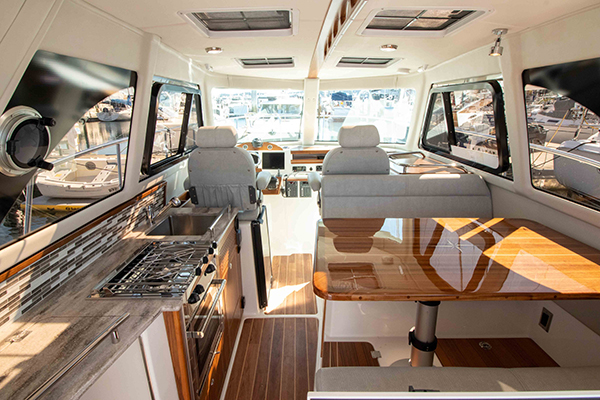
Aspens are designed to cruise, are well laid out for easy operation, and built to a high standard. Their unique patented PROA design makes them remarkably efficient and gives them a smooth comfortable ride. They have proven seakeeping abilities and enough range to allow voyages into remote areas. If you have an adventuresome spirit and like catamarans Aspen powercats deliver in so many ways and deserves serious consideration.
Read more about Aspen Powercats here.
